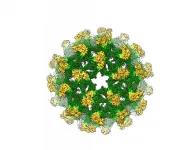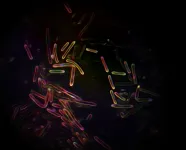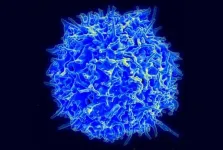(Press-News.org) In research made possible when COVID-19 sidelined other research projects, scientists at Johns Hopkins Medicine meticulously counted brain cells in fruit flies and three species of mosquitos, revealing a number that would surprise many people outside the science world.
The insects' tiny brains, on average, have about 200,000 neurons and other cells, they say. By comparison, a human brain has 86 billion neurons, and a rodent brain contains about 12 billion. The figure probably represents a "floor" for the number needed to perform the bugs' complex behaviors.
"Even though these brains are simple [in contrast to mammalian brains], they can do a lot of processing, even more than a supercomputer," says Christopher Potter, Ph.D., associate professor of neuroscience at the Johns Hopkins University School of Medicine. "They enable the insects to navigate, find food and perform other complicated tasks at the same time, and our study offers one answer to the question of how many brain cells come together to conduct these behaviors," Potter adds.
Results of the research are summarized May 14 in PLOS ONE.
Those who study insect behavior and brain function have long suspected these insects must have hundreds of thousands of brain cells, says Potter, but when he and postdoctoral fellow Joshua Raji, Ph.D., followed chains of scientific papers that referenced the count, they did not find proof for it.
In response, they report, they set out to find proof using a relatively simple counting method called an isotropic fractionator, a technique familiar to pathologists when they tally the number of any type of cell in a tissue.
First, Raji used a plastic pestle to break down all the brain tissue of the individual insects. Then, he used a pipette to break apart the tissue and distribute the cells evenly through a buffered solution.
Knowing the precise total volume of the solution, they could then count cells within a small fraction of the solution, and scale it up to account for and estimate the total number of cells in the entire solution.
To make the actual count, the small amount of solution was spread on a microscope slide and placed on top of a small grid. With painstaking precision, Raji counted the cells on each slide, one by one.
The researchers concluded that the total sum of brain cells was 199,380 plus or minus 3,400 for the fruit fly Drosophila melanogaster. For three species of mosquito, the researchers found 217,910 plus or minus 6,180 in Aedes aegypti; 223,020 plus or minus 4,650 in Anopheles coluzzii; and 225,911 plus or minus 7,220 in Culex quinquefasciatus.
Raji and Potter found that the brain cells in each species contained mostly neurons -- about 90%. The rest are most likely supportive cells called glia, they say.
Potter says that researchers have determined the number of brain cells in only a few species of insects, including wasps and ants. "It would be interesting to apply this approach to social insects like bees, and see if there are differences between queens and drones," he says.
Potter also notes that the counting technique is a simple one that most researchers could perform, and it's an opportunity for any researcher to perform the counts and contribute them to scientific literature.
Raji noted that he did most of the work for the study as a side project during times when COVID-19 restrictions halted his main research projects.
The most challenging part of the technique, says Potter, was the microdissection of a brain that is smaller than the tip of a pencil. "It takes a really steady hand and lots of practice," he says.
INFORMATION:
This work was supported by grants from the Department of Defense (W81XWH-17-PRMRP), from the National Institutes of Health (NIAID R01Al137078) and a Johns Hopkins Malaria Research Institute postdoctoral fellowship.
Being treated fairly is important - but fairness alone isn't enough to make people feel valued in a workplace or other groups, new research suggests.
Researchers found that "distinctive treatment" - where a person's talents and qualities are recognised - provides this sense of value while also reinforcing their sense of inclusion. It also promotes mental health.
The findings suggest there is no conflict between "fitting in" and "standing out" in groups - in fact, they complement each other.
But while the importance of fairness is widely accepted, the researchers say distinctive treatment is ...
AMES, Iowa - The field photos show the hard, rough country that some glaciers slide over: rocky domes and bumps in granite, rocky steps and depressions in limestone. The glacier beds dwarf the researchers and their instruments. (As do the high mountains pictured on the various horizons.)
During their trips to glacier beds recently exposed by retreating glaciers in the Swiss Alps (Rhone, Schwarzburg and Tsanfleuron glaciers) and the Canadian Rockies (Castleguard Glacier), four glaciologists used laser and drone technology to precisely measure the rocky beds and record their very different contours.
The researchers turned the measurements into high-resolution digital models of those glacier beds. Then they went to work with manageable but representative subunits of the ...
Better designed vaccines for insect-spread viruses like dengue and Zika are likely after researchers discovered models of immature flavivirus particles were originally misinterpreted.
Researchers from The University of Queensland and Monash University have now determined the first complete 3D molecular structure of the immature flavivirus, revealing an unexpected organisation.
UQ researcher Associate Professor Daniel Watterson said the team was studying the insect-specific Binjari virus when they made the discovery.
"We were using Australia's safe-to-handle Binjari virus, which we combine with more dangerous viral genes to make safer and more effective vaccines," Dr Watterson ...
ITHACA, NY, May 13, 2021 -- Cyanobacteria are one of the unsung heroes of life on Earth. They first evolved to perform photosynthesis about 2.4 billion years ago, pumping tons of oxygen into the atmosphere - a period known as the Great Oxygenation Event - which enabled the evolution of multicellular life forms.
Led by BTI faculty member END ...
The United States has witnessed a steep rise in reports, arrests, and media coverage of teachers' sexual misconduct with students. A new study investigated the impact of perpetrators' gender, sexuality, and age on perceptions of teacher sexual misconduct. The study found that
responses to teachers' misconduct varied according to certain characteristics, which can influence whether victims report the misconduct.
The study, by researchers at Prairie View A&M University and the University of Nevada, Reno, appears in Feminist Criminology.
"Because sexual abuse of a child or adolescent in any context has substantial psychological, emotional, and physical consequences for the victim, teachers' sexual misconduct is a serious public health ...
Developing self-healing materials is nothing new for Nancy Sottos, lead of the Autonomous Materials Systems Group at the END ...
Three billion years ago, light first zipped through chlorophyll within tiny reaction centers, the first step plants and photosynthetic bacteria take to convert light into food.
Heliobacteria, a type of bacteria that uses photosynthesis to generate energy, has reaction centers thought to be similar to those of the common ancestors for all photosynthetic organisms. Now, a University of Michigan team has determined the first steps in converting light into energy for this bacterium.
"Our study highlights the different ways in which nature has made use of the basic reaction ...
May 14, 2021 - Two thirds of all pediatric spinal fractures, especially in the adolescent population, occur in motor vehicle accidents (MVAs) where seatbelts are not utilized, reports a study in Spine. The journal is published in the Lippincott portfolio by Wolters Kluwer.
"Over 60 percent of pediatric spinal fractures occur in children ages 15 to 17, coinciding with the beginning of legal driving," according to the new research by Dr. Vishal Sarwahi, MD, of Cohen Children's Medical Center, New Hyde Park, NY, and colleagues. They emphasize the need for measures to increase seatbelt usage, particularly by younger drivers, and outline the potential trauma that can be avoided through proper seatbelt use.
Seatbelts save lives... and ...
May 14, 2021 - Two years ago, the Veterans Affairs healthcare system (VA) began rolling out a new benefit, enabling Veterans to receive urgent care from a network of community providers - rather than visiting a VA emergency department or clinic. Progress toward expanding community care services for Veterans is the focus of a special supplement to the May issue of Medical Care. The journal is published in the Lippincott portfolio by Wolters Kluwer.
The urgent care benefit "provides a new way to deliver unscheduled, low-acuity acute care to Veterans," according to the ...
A team led by researchers at Weill Cornell Medicine and Children's National Hospital has developed a unique pre-clinical model that enables the study of long-term HIV infection, and the testing of new therapies aimed at curing the disease.
Ordinary mice cannot be infected with HIV, so previous HIV mouse models have used mice that carry human stem cells or CD4 T cells, a type of immune cell that can be infected with HIV. But these models tend to have limited utility because the human cells soon perceive the tissues of their mouse hosts as "foreign," ...




